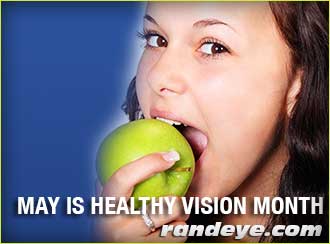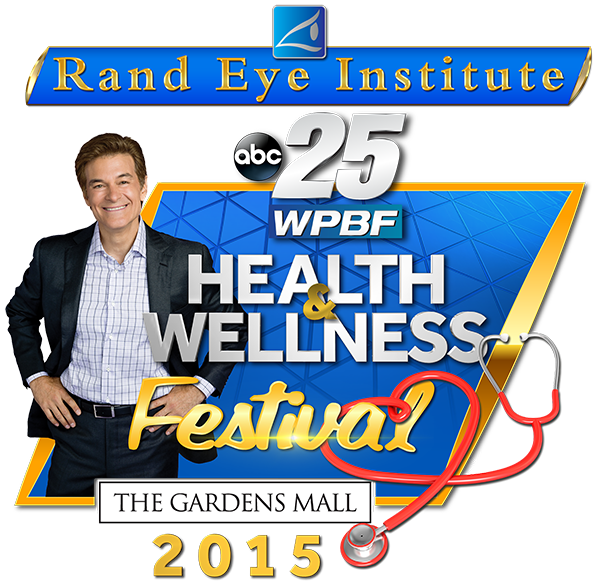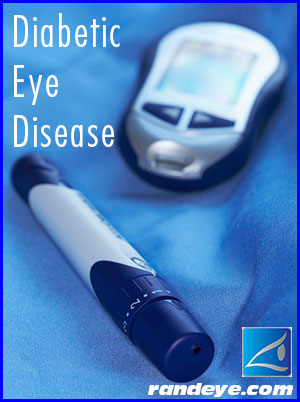Tips for Independent Senior Living
There is a lot you can do to ensure an easy life for seniors who choose to live an independent life. Here are some small changes you can make, that will help your loved one live an easier life.
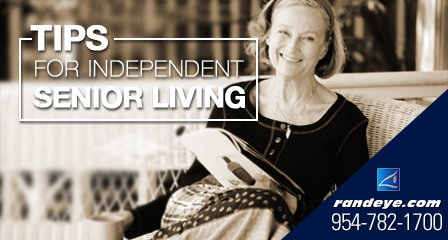
See an Ophthalmologist
Those with low vision can improve their quality of life through low vision rehabilitation, which teaches people how to use their remaining sight more effectively and can be arranged through an ophthalmologist – a medical doctor specializing in the diagnosis, medical and surgical treatment of eye diseases and conditions.
Make things Bigger
Sit closer to the television or to the stage at performances. Get large books, phone dials and playing cards. Also, carry magnifiers for help with menus, prescription bottles and price tags.
Make things Brighter
Make sure areas are well lit and cover shiny surfaces to reduce glare. For instance, drink coffee from a white mug and always use a felt-tipped pen with black ink.
Use Technology
Many of today’s newer technologies have applications that can help with low vision. For example, e-readers allow users to adjust the font size and contrast. Many smartphones and tablets can be used to magnify print, identify cash bills and provide voice-navigated directions.
Organize and Label
Designate spots for your keys, wallet and frequently used items in your refrigerator. Mark thermostats and dials with high contrast markers from a fabric store; label medications with markers or rubber bands; and safety-pin labels onto similarly colored clothing to tell them apart.
Eye Checkup for Seniors
Seniors enjoy their independence just as we do! That’s why regular checkups and screenings are very important, as you age.
An annual eye checkup is a simple, low-stress way to keep tabs on your eye and overall health.
Here are some of the things your doctor will be looking for:
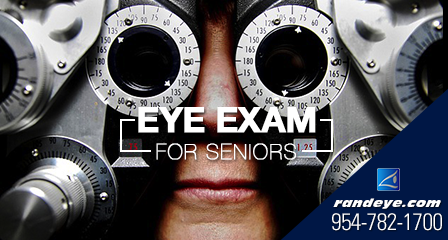
Age-related macular degeneration (AMD)
This is the leading cause of blindness among seniors. But, early detection and treatment can slow its progress significantly. There are a couple different types of AMD. The type determines the treatment – ranging from laser surgery, medication or dietary supplements to slow the disorder.
Glaucoma
Glaucoma has been called, “the silent thief of sight” because too often, it goes unnoticed before too much damage is done to save vision. It’s caused by too much pressure in the eyes. When doctors catch it early, they can often manage it effectively and prevent vision loss.
Cataracts
Cataracts are a nearly unavoidable part of aging. Over time, the lens in the eyes can get cloudy and yellow. But, updated eyewear prescriptions can often delay surgery, which is easy and low-risk.
Diabetic retinopathy
This affects diabetic patients and can rob sight. The tiny blood vessels in the eye that feed the retina become damaged and allow fluids to seep into the eye. Treatment includes changes in diet and exercise, and also surgery.
Refractive errors
Vision changes and usually worsens with age. A yearly checkup will help keep vision sharp with updated eyewear prescriptions.
Healthy Eye Tips for Those Over 60!
Nutrition Is a key component in healthy eyes
To keep your eyes working healthy and properly, choose foods that are rich in antioxidants like vitamin A and C, such as leafy, green vegetables and fish. Many foods, especially fish, contain omega-3 fatty acids that are essential to the health of macula and other parts of the eye.

Smoking affects eye health, too
Smoking exposes your eyes to high levels of oxidative stress. Smoking increases the risk of developing a variety of conditions that affect your eye health.
Step away from your computer screen
After hours of staring at the computer, your eyes end up feeling the same kind of repetitive stress in your eye muscles as your wrists. When working on the computer, try to:
- Keep your computer at a 20’-24’ distance from your eyes.
- Keep the top of your computer screen slightly below your eyes.
- Adjust the lighting to minimize glares on your screen.
- Take a break every 15 minutes to focus on an object in the distance.
- Remember to blink frequently!
Exercise
Believe it or not, exercise is very important for eye health. Exercise helps improve blood circulation, which, in return, improves oxygen levels to the eyes and the removals of toxins. Regular exercise also helps keep our weight in the normal range, which reduces the risk of diabetes and diabetic retinopathy.
We are celebrating senior independence month this July
Each day approximately 10,000 Americans turn 65 and one in every six adults this age and older has some type of vision impairment that cannot be corrected with either glasses or contacts.
As we celebrate our independence this July, it is important to keep in mind the independence of our older loved ones.
To ensure a safe and happy independent lifestyle, we need to make sure that our eyes are working at their best.
Here are some 7 sight-saving habits that will help maintain independence for seniors.
1. Get an Eye Exam.
Adults age 65 and over should get a medical eye exam every one-to-two years. Regular eye exams are very important in spotting changes in vision, which could be a symptom for a serious eye disease or condition.
2. Know the Symptoms of Vision Loss.
Signs of vision loss may become apparent when reading, writing, shopping, watching television, driving a car or even recognizing faces becomes more difficult. You vision problems may cause you to bumping into or knocking over objects, take steps hesitantly, squinting or tilting the head when trying to focus. If you’ve had to do any of these, let your doctor know!
3. Make Eye-Healthy Food Choices.
A diet low in fat and rich in fruits, vegetables and whole grains benefits the entire body, including the eyes. Studies show that foods rich in vitamins C and E, zinc, lutein and zeaxanthin are good for eye health. Some eye-healthy foods include citrus fruits, vegetable oils, nuts, whole grains, dark green leafy vegetables and cold-water fish.
4. Quit Smoking.
Avoiding smoking and second hand smoke – or quitting, for current smokers – are some of the best investments everyone can make for long-term eye health. Smoking increases risk for eye diseases like cataract and age related macular degeneration and can raise the risks of cardiovascular diseases that can influence the eye problems.
5. Maintain Normal Blood Pressure, Cholesterol and Glucose Levels.
High blood pressure, cholesterol and blood glucose levels can all lead to an increase risk of vision loss from an eye disease. Always try to keep these levels under control, and maintain a healthy lifestyle.
6. Get Regular Physical Activity.
Thirty minutes of exercise a day can benefit your heart, waistline and energy levels, and also do some good for your eyesight! Many eye diseases are linked to other health problems, such as high blood pressure, diabetes and high cholesterol levels.
7. Wearing Sunglasses.
Exposure to ultra violet (UV) light can raise the risks of some eye problems, including cataract, growths on the eye and cancer. Always wear sunglasses with 100 percent UV protection, and a hat while enjoying time outdoors.
Kids UV Protection
Kids Need UV Protection More Than Adults
The risk of damage to our eyes and skin from solar UV radiation is very high. The danger continues to increase as we spend more and more time in the sun throughout our lifetime.
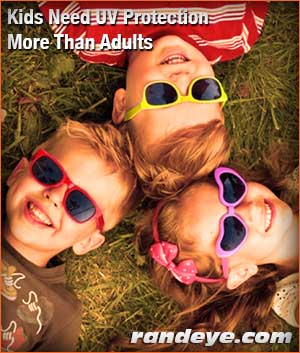
It is especially important for kids to protect their eyes from the sun. Children generally spend much more time outdoors than adults.
Some experts say that because children tend to spend significantly more time outdoors than most adults, up to half of a person’s lifetime exposure to UV radiation can occur by age 18.
Children are also more susceptible to retinal damage from UV rays because the lens inside a child’s eye is clearer than an adult lens, enabling more UV to penetrate deep into the eye.
Make sure your kids’ eyes are protected from the sun with good quality sunglasses!
Best Sunglasses for UV Radiation Protection
Getting healthy eyes may be as simple as wearing your sunglasses!
The sun’s primary danger is Ultraviolet (UV) radiation. UV radiation is a component of solar radiation, but it can also be given off by artificial sources like welding machines, tanning beds and lasers.
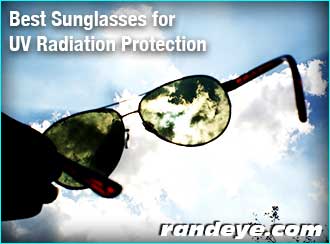
Most people are aware of the harm UV radiation can do to the skin, but many may not realize that exposure to UV radiation can harm the eyes or that other components of solar radiation can also affect vision.
If your eyes are exposed to excessive amounts of UV radiation over a short period of time, you are likely to experience an effect called photokeratitis, which is like “sunburn of the eye”.
Photokeratitis may be painful and include symptoms such as red eyes, a foreign body sensation or gritty feeling in the eyes, extreme sensitivity to light and excessive tearing. Fortunately, this is usually temporary and sometimes permanent damage to the eyes.
Long-term exposure to UV radiation can be more very serious. Scientific studies have shown that exposure to small amounts of UV radiation over a period of many years increases the chance of developing a cataract and may cause damage to the retina, a nerve-rich lining of the eye that is used for seeing.
The longer the eyes are exposed to solar radiation, the greater the risk of developing later in life such conditions as cataracts or macular degeneration. Since it is not clear how much exposure to solar radiation will cause damage, the AOA recommends wearing quality sunglasses that offer UV protection and wearing a hat or cap with a wide brim whenever you spend time outdoors. Also, certain contact lenses can provide additional UV protection.
To provide adequate protection for your eyes, sunglasses should:
-
Block out 99 to 100 percent of both UV-A and UV-B radiation;
-
Screen out 75 to 90 percent of visible light;
-
Have lenses that are gray for proper color recognition
-
The lenses in sunglasses should be made from polycarbonate
Remember to always wear eye protection, to reduce the effects of UV radiation.
Keep an Eye on Your Vision
Healthy Vision Month is a great opportunity to learn about eye health and to make sure you and your family are taking the necessary steps to maintain healthy eyes.
Early detection of eye disease is key in preventing vision loss and blindness. Many people who are at risk for vision loss do not know it, and millions of people living in the United States have undetected vision problems and eye diseases.
Many common eye diseases that can lead to vision loss and blindness, such as diabetic eye disease, glaucoma, or age-related macular degeneration (AMD), often have no early warning signs or symptoms.
Having regular eye exams to make sure the eyes are healthy and seeing their best is important for everyone. However, the risk of vision loss and blindness is higher for some people based on race, ethnicity, and other demographic and socioeconomic factors.
You might be at higher risk for eye disease if you have a family history of eye disease; have diabetes; are African American, Hispanic/Latino, American Indian, or Alaska Native; or are older than 50. 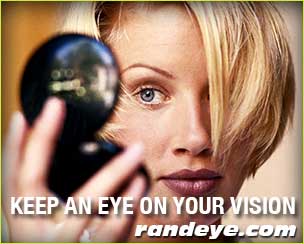
- Glaucoma, which affects your side or peripheral vision first, is three times more common in African Americans than in Whites. It is a leading cause of blindness in African Americans.
- Diabetic retinopathy, a leading cause of blindness caused by uncontrolled diabetes, occurs more often in Hispanics/Latinos than in Whites.
- American Indians and Alaska Natives are 35 percent more likely to have diabetes than the average adult in the United States, putting them at increased risk of diabetic eye disease.
- Older adults are at higher risk of developing age-related eye diseases and conditions such as AMD, glaucoma, or cataract. AMD is a leading cause of blindness in Whites.
In addition to having regular eye exams, eating a healthy diet, not smoking, and wearing protective eyewear are just a few other things you can do to protect your sight.
May is Healthy Vision Month
It is important to keep our eyes healthy. Here are some ways you can do just that!
Get a dilated eye exam.
Getting a dilated eye exam is the only way to catch eye diseases early, because with many, there are no warning signs. Talk to your eye care professional about how often you should have one.
Live a healthy lifestyle.
Eating healthy foods, maintaining a healthy weight, managing chronic conditions, and not smoking can lower your risk of eye disease.
Know your family history.
Talk to your family members about their eye health history. It’s important to know if anyone has been diagnosed with an eye disease, since many are hereditary. This will help to determine if you are at higher risk for developing an eye disease yourself.
Use protective eyewear.
Protect your eyes when doing chores around the house, playing sports, or on the job to prevent eye injuries from happening. This includes wearing safety glasses, goggles, safety shields, and eye guards that are made of polycarbonate.
Wear sunglasses.
When purchasing sunglasses, look for ones that block out 99 to 100% of both UVA and UVB radiation, so you can keep your vision sharp and eyes healthy. A hat offers great protection, too!
WPBF 25 Dr. Oz Health & Wellness Festival 2015
Join Us! At the Palm Beach Gardens mall this saturday and visit the Rand Eye Institute’s booth for the Annual WPBF 25 Dr. Oz Health & Wellness Festival 2015.
WPBF 25 Dr. Oz
Health & Wellness Festival 2015
Saturday, March 28th
10AM – 4PM
Location: The Gardens Mall
3101 PGA Boulevard
Palm Beach Gardens, FL 33410
Dr. Oz will be bringing his exciting health show LIVE to the Gardens Mall with 2 NEW must hear presentations!
Lisa Oz, best-selling author, show host and editor of Dr. Oz’s magazine The Good Life, joins her husband on stage! She will be presenting her holistic family medicine and will provide tips on how to cook healthier versions of some of your favorite dishes.
Visit the Rand Eye Institute’s booth, at the Dr. Oz Health and Wellness Festival, and enter our raffle giveaway for a chance to win one of 2 Spa finder gift cards. The winner will be drawn at the end of the Health and Wellness Festival. You do not need to be present to win. Only 1 entry per person. Some restrictions apply.* 18 years or older to enter. *
THIS IS A FREE OPEN TO THE PUBLIC EVENT.
Diabetic Eye Disease – Awareness Month
Diabetes is the leading cause of blindness in working-age Americans.
According to the American Academy of Ophthalmology, about 29 million Americans, 20 or older have diabetes and almost one-third does not even know they have the disease and are at risk for losing their vision.
Early symptoms of diabetes can often go undetected and vision may not be affected until the disease is more severe and even harder to treat. Some symptoms that are usually quick to detect include:
- Frequent urination
- Excessive thirst
- Weight loss/weight gain
- Increased hunger
- Tiredness
- Lack of focus
- Numbness in the hands or feet
A group of eye problems can arise due to diabetes. Cataracts and glaucoma are only a couple of vision stealing side effects. If you have diabetes you may get cataracts at a younger age, and your chances of developing glaucoma doubles.
Early diagnosis of diabetes and maintaining a strict control of blood sugar and hypertension through a balanced diet, exercise and medication can help reduce your risk of developing eye disease that is associated with diabetes. Eye doctors are often the first to detect diabetes, so setting up annual appointments with your doctor can be life saving.


